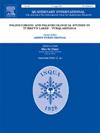罗马时代维苏威地区特殊沉积条件造成的烧焦和萎缩花粉粒
IF 1.9
3区 地球科学
Q3 GEOGRAPHY, PHYSICAL
引用次数: 0
摘要
尽管在公元 79 年火山爆发期间,维苏威地区的许多土壤样本被突然掩埋,但花粉含量很低或根本没有花粉。这项研究评估了碳化过程是否可能导致花粉粒的全部或部分丢失,或者至少是在花粉分析过程中没有记录下来。在奥普朗蒂斯的植物材料中发现了一定数量的花粉粒,这使得研究这些花粉粒可能经历过的加热条件成为可能。为此,本研究将现代花粉粒暴露在不同温度下的不同时间间隔内,以观察其变化情况。收集到的数据表明,暴露在高温下,即使时间很短,也会对花粉粒产生重大影响,以至于在古生物学分析中无法检测到。与 Oplontis 类似的现代花粉粒在 300 °C 下暴露 15 分钟后即可观察到。从 Oplontis 网状花粉粒的保存状况来看,不可能长时间暴露在 300 °C 或更高的温度下。所获得的温度指标与其他研究的数据相符。燃烧假说也可以解释维苏威遗址中发现的许多颗粒尺寸较小的原因。本文章由计算机程序翻译,如有差异,请以英文原文为准。
Charred and shrunken pollen grains as a result of special depositional conditions in the Roman age Vesuvian area
Despite the sudden burial to which they were subjected during the eruption of 79 AD, many of the soil samples from the Vesuvian area are poor or devoid of pollen. This research assesses whether a carbonization process may be responsible for the complete or partial loss of pollen grains or, at very least, for them going unrecorded during pollen analyses. The discovery of a certain number of pollen grains in plant material from Oplontis has made it possible to investigate which heating conditions they may have been subjected to. For this purpose, in this study, modern pollen grains were exposed to different temperatures for different time intervals in order to observe their modification. The data collected indicate that exposure to high temperatures, even for a short time, can significantly impact pollen grains to the point of making them undetectable during palynological analyses. Modern pollen grains similar to those of Oplontis are observed after exposure to 300 °C for 15 min. The state of preservation of the Oplontis reticulate grains makes prolonged exposure to 300 °C or higher temperatures unlikely. The temperature indications obtained are compatible with data from other studies. The hypothesis of combustion may also explain the small dimensions of many grains found in the Vesuvian sites.
求助全文
通过发布文献求助,成功后即可免费获取论文全文。
去求助
来源期刊

Quaternary International
地学-地球科学综合
CiteScore
5.60
自引率
4.50%
发文量
336
审稿时长
3 months
期刊介绍:
Quaternary International is the official journal of the International Union for Quaternary Research. The objectives are to publish a high quality scientific journal under the auspices of the premier Quaternary association that reflects the interdisciplinary nature of INQUA and records recent advances in Quaternary science that appeal to a wide audience.
This series will encompass all the full spectrum of the physical and natural sciences that are commonly employed in solving Quaternary problems. The policy is to publish peer refereed collected research papers from symposia, workshops and meetings sponsored by INQUA. In addition, other organizations may request publication of their collected works pertaining to the Quaternary.
 求助内容:
求助内容: 应助结果提醒方式:
应助结果提醒方式:


